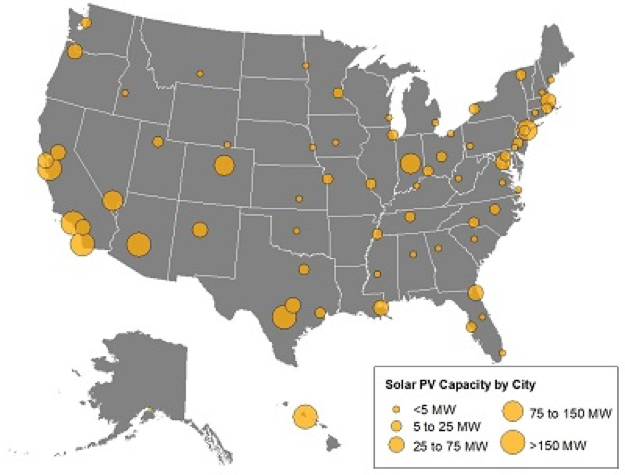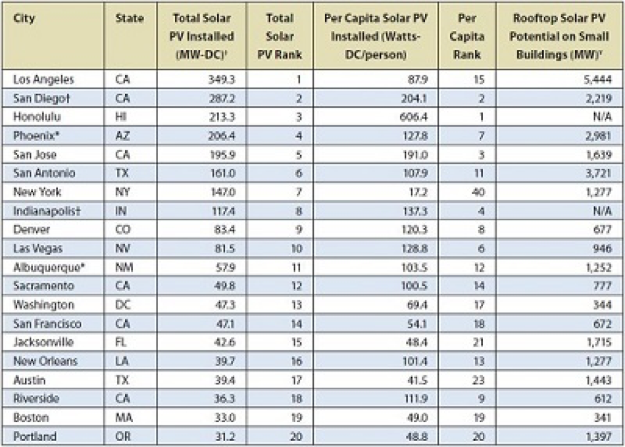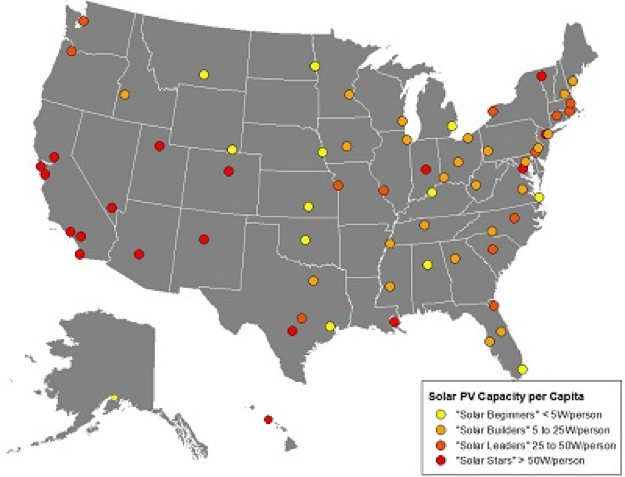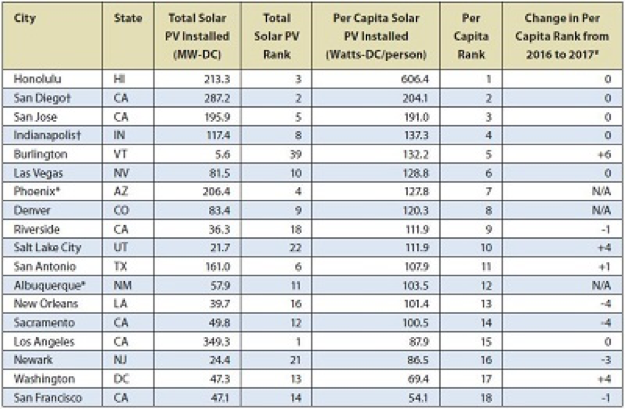Shining Cities 2018: How Smart Local Policies Are Expanding Solar Power in America
Solar power is expanding rapidly. The United States now has over 53 gigawatts (GW) of solar photovoltaic (PV) capacity installed – enough to power 10.1 million homes and 26 times as much capacity as was installed at the end of 2010.[1] Hundreds of thousands of Americans have invested in solar energy and millions more are ready to join them.
Downloads
Executive Summary
Solar power is expanding rapidly. The United States now has over 53 gigawatts (GW) of solar photovoltaic (PV) capacity installed – enough to power 10.1 million homes and 26 times as much capacity as was installed at the end of 2010.[1] Hundreds of thousands of Americans have invested in solar energy and millions more are ready to join them.
America’s major cities have played a key role in the clean energy revolution and stand to reap tremendous benefits from solar energy. As population centers, they are major sources of electricity demand and, with millions of rooftops suitable for solar panels, they have the potential to be major sources of clean energy as well.
Solar power can allow cities to curb emissions that contribute to global warming, become more resilient to severe weather, help residents stabilize their energy bills, and improve public health through reduced air pollution.
As of the end of 2017, 20 cities—representing just 0.1 percent of U.S. land area—accounted for over 4 percent of U.S. solar PV capacity. These 20 cities have over 2 GW of solar PV capacity—more solar power than the entire country had installed by the end of 2010.[2]
Los Angeles leads the nation in total installed solar PV capacity among the 69 cities surveyed in this report, as it did between 2013 and 2015 before being temporarily overtaken by San Diego in 2016. (See Table ES-1.)
Figure ES-1. Major U.S. Cities by Cumulative Installed Solar PV Capacity, End of 2017 (MW)

Table ES-1. Top 20 Solar Cities by Total Installed Solar PV Capacity, End of 2017

The cities with the most solar PV installed per capita are the “Solar Stars” – cities with 50 or more watts of solar PV capacity installed per person. Honolulu has nearly three times as much solar PV per capita as the next leading city, San Diego. All of the “Solar Stars” have experienced dramatic growth in solar energy and are setting the pace nationally for solar energy development. In 2013, only eight of the cities surveyed for this report had enough solar PV per capita to be ranked as “Solar Stars,” but now 18 cities have earned the title. (See Figure ES-2 and Table ES-2.)
Leaders in per capita solar capacity by census region include Honolulu in the Pacific region, Las Vegas in the Mountain region, Indianapolis in the North Central region, San Antonio in the South Central region, Washington, D.C., in the South Atlantic region and Burlington, Vermont, in the Northeast region.
Figure ES-2. Major U.S. Cities by Installed Solar PV Capacity Per Capita, End of 2017 (Watts per Person)

Table ES-2. The “Solar Stars” (Cities with 50 or More Watts of Solar PV per Person, End of 2017)

Many smaller cities and towns are also going big on solar energy. Many smaller communities have installed as much solar PV per capita as the leading cities included in this survey.
- Fresno, California, has 343 watts of solar PV capacity installed per resident – more than any large city surveyed, with the exception of Honolulu.[1]
- Santa Fe, New Mexico, would rank among the top “Solar Stars” on our list with 203 watts of solar PV installed per resident.[2]
- Tucson, Arizona, would also rank among the top “Solar Stars” with 183 watts of solar PV installed per resident.[3]
Fossil fuel interests and some utilities are working to slow the growth of distributed solar energy. During 2017 alone, 19 utilities in 10 states requested to add or increase electric bill charges for rooftop solar customers.[4] And, over the past few years many states have considered or passed cuts to net metering – the critical practice of crediting solar energy customers for the excess energy they supply to the grid.[5]
U.S. cities have only begun to tap their solar energy potential. Some of the cities on this list could generate hundreds of times more solar power, and the majority could generate at least 50 times more solar power than they currently do on the rooftops of small buildings alone, according to a National Renewable Energy Laboratory (NREL) analysis.[6] Cities can go even farther by encouraging solar installations on large buildings and stand-alone utility-scale installations.
To take advantage of that potential and move America toward an economy powered by 100 percent renewable energy, city, state and federal governments should adopt a series of pro-solar policies.
- Local governments should, among other things:
– Implement solar access ordinances to protect residents’ right to generate solar energy on their own property.
– Make permitting, zoning and inspection processes easy, quick and affordable.
– Expand access to solar energy to apartment dwellers, low-income residents, small businesses, and nonprofits through low-interest financing programs, power purchase agreements (PPAs), collective purchasing programs, and community solar projects.
– Support and push for strong state-level solar policies, especially by combining efforts with other communities.
- State governments should, among other things:
– Set or increase renewable energy targets for utilities and adopt specific requirements for solar energy adoption.
– Adopt and preserve strong statewide interconnection and net metering policies.
– Ensure that electric rate designs encourage solar adoption.
– Establish public benefits charges on utility bills or other sustainable financing mechanisms for solar energy.
- The federal government should, among other things:
– Continue and expand financing support for solar energy, particularly the Investment Tax Credit.
– Support research to drive solar power innovations, such as the U.S. Department of Energy’s Solar Energy Technologies Office.
– Defend and strengthen the requirements of the Clean Power Plan.
